Award of Excellence
Operative Platform
Hansol Kang, Student ASLA, Graduate, Harvard Graduate School of Design
Faculty Advisors: Gary Hilderbrand, FASLA, David Mah, Miho Mazereeuw and Chris Reed, ASLA
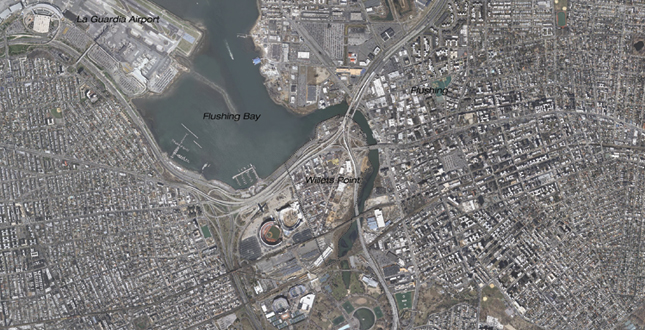 Close Me!
Close Me!Site Plan. Willets Point, Queens, New York City, NY, USA.
Download Hi-Res ImageImage: Hansol Kang
Image 1 of 18
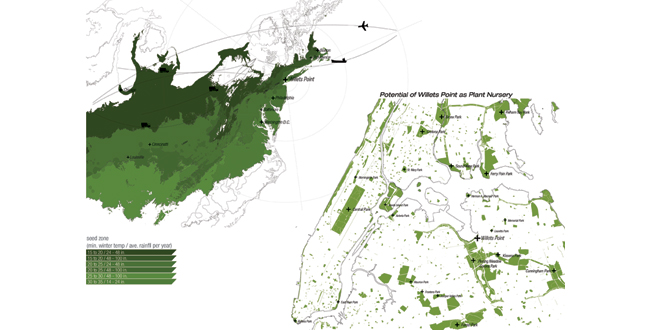 Close Me!
Close Me!Issue of Plant Nursery. High cost for importing and transporting of seed, seedling, grown plants / Public realm around Willets Point including Queens, Manhattan.
Download Hi-Res ImageImage: Hansol Kang
Image 2 of 18
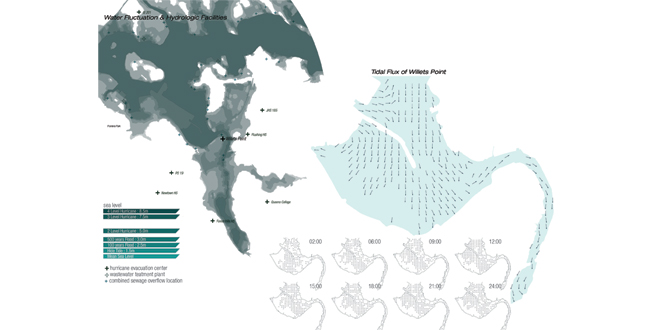 Close Me!
Close Me!Issue of Hydrology. Risky posiion of Willets Points relates to flooding, hurricane / Dynamic tidal fluctuation and main flow direction of rising tide.
Download Hi-Res ImageImage: Hansol Kang
Image 3 of 18
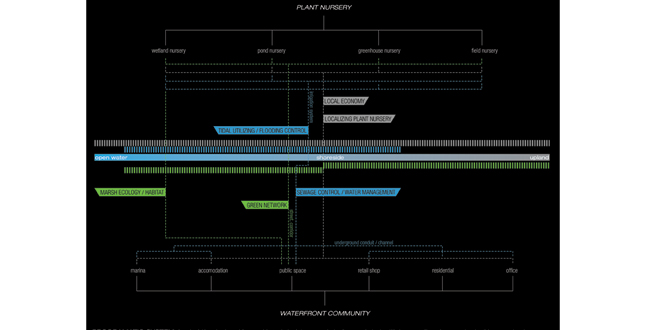 Close Me!
Close Me!Programatic System. Agenda of this project is providing new vision and role of plant nursery in the discourse of urbanism. Whole system will contribute not only to localizing nursery but also to water management of the region.
Download Hi-Res ImageImage: Hansol Kang
Image 4 of 18
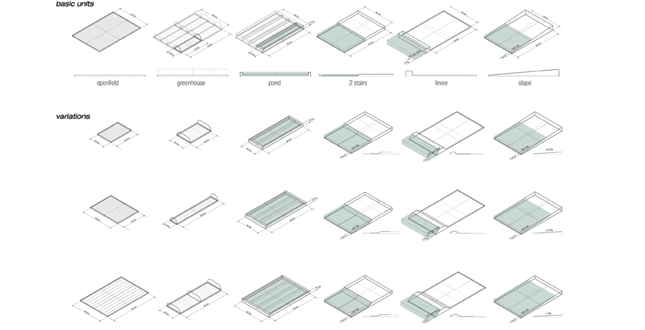 Close Me!
Close Me!Catalogue of Units 1. Fields will be prepared with several versions of variation in regard with different usage, plant species, water fluctuation and etc.
Download Hi-Res ImageImage: Hansol Kang
Image 5 of 18
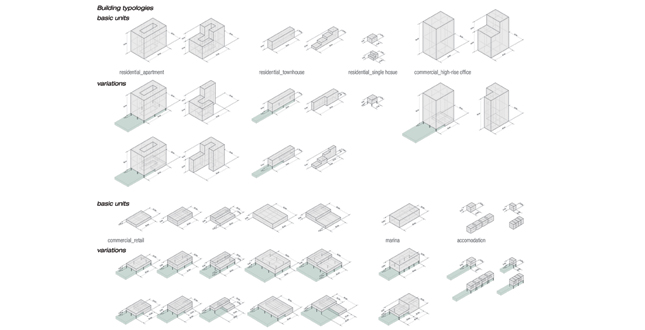 Close Me!
Close Me!Catalogue of Units 2. Buildings will be corespond to danger of water level change with piloti structure. Also terraced morphology will not disturb the sunlight for plant nursery fields.
Download Hi-Res ImageImage: Hansol Kang
Image 6 of 18
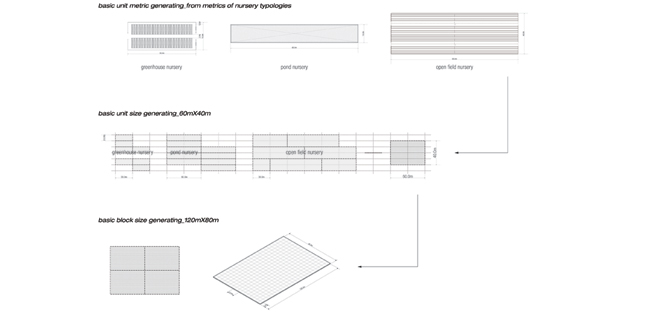 Close Me!
Close Me!Urban Metric Generation. Basic grid, urban block and unit size is extracted from the metrics of plant nursery. These base dimension and structure will be the foundation of new urbanism.
Download Hi-Res ImageImage: Hansol Kang
Image 7 of 18
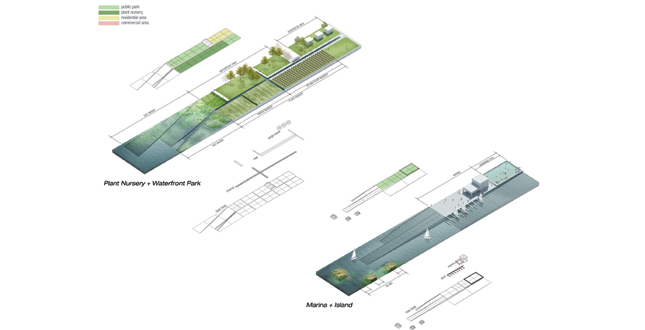 Close Me!
Close Me!Performative Compositions 1. Series of fields and building organized with urban lanscape. Also they perform within a inter-relations among them and construct waterfront urban system.
Download Hi-Res ImageImage: Hansol Kang
Image 8 of 18
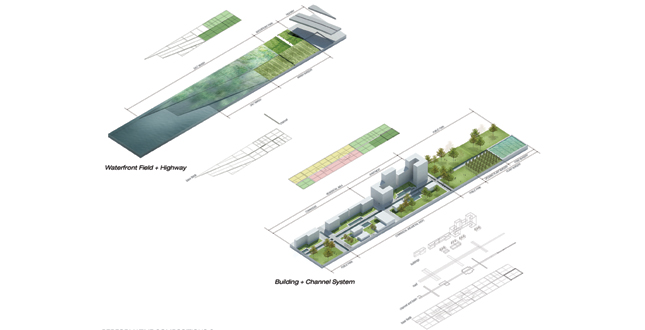
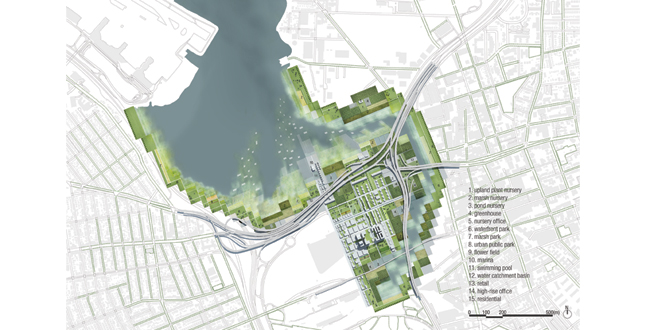
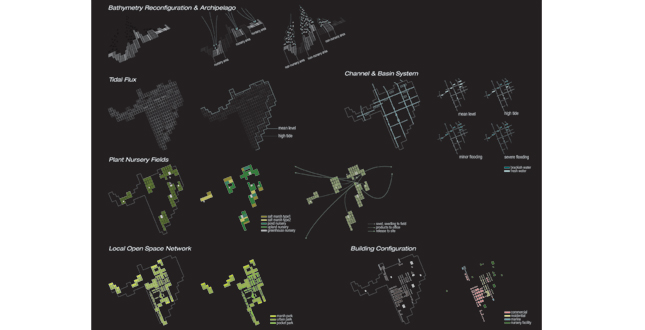 Close Me!
Close Me!Performative Components. Modified underwater topography, channel and basin, nursery fields, open space and building. Several sets of components weave the platforms of whole site and make them operate closely.
Download Hi-Res ImageImage: Hansol Kang
Image 11 of 18
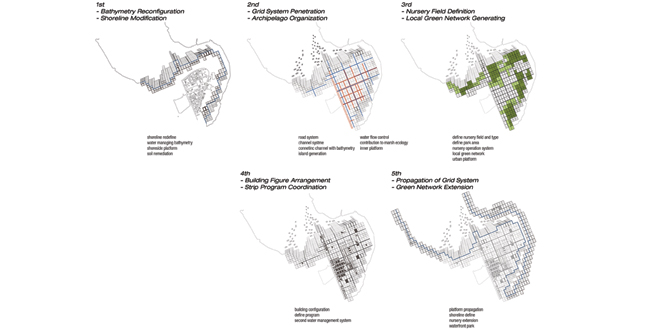 Close Me!
Close Me!Sequential Processes. Site organizing processes will be carried out in sequence. Each steps has its own goal and target works and also provides base for next steps in relation.
Download Hi-Res ImageImage: Hansol Kang
Image 12 of 18
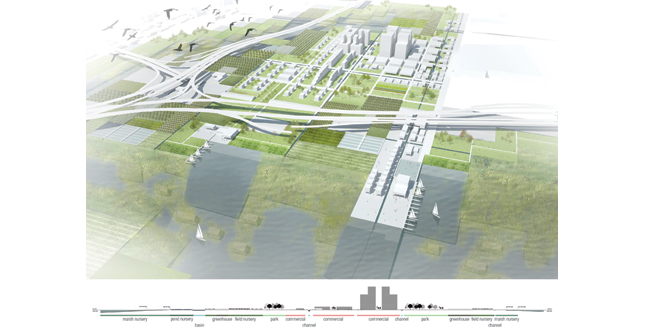 Close Me!
Close Me!Overall Performance. Willets Point which renewed by plant nursery urbanism. Industrial plant nursery, urban living area and flushing bay will be connected within new scheme of nursery urbansim.
Download Hi-Res ImageImage: Hansol Kang
Image 13 of 18
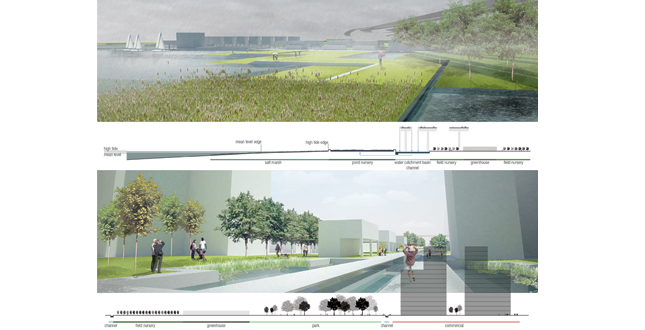 Close Me!
Close Me!Perspectives. Two perspectives that shows relationship between platform and highway / building with channel and basin system.
Download Hi-Res ImageImage: Hansol Kang
Image 14 of 18
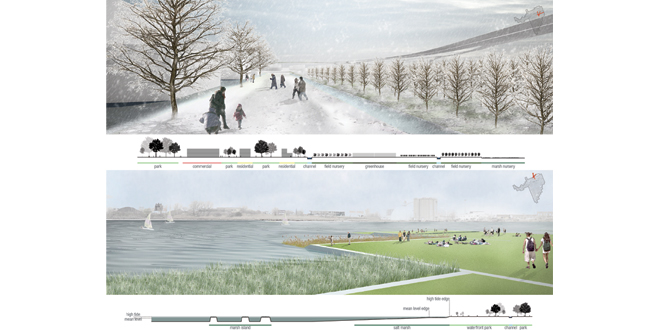 Close Me!
Close Me!Perspectives. Two images of urban nursery field in winter season / waterfront park.
Download Hi-Res ImageImage: Hansol Kang
Image 15 of 18
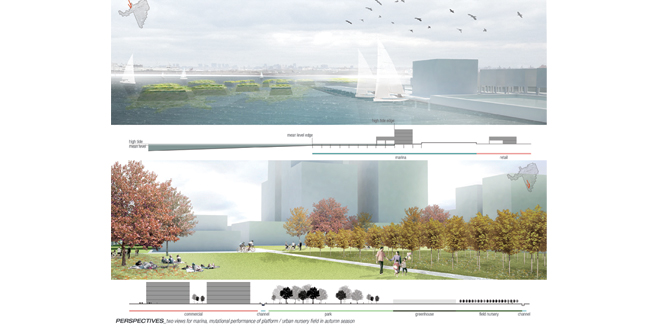 Close Me!
Close Me!Perspectives. Two images of urban nursery field in winter season / waterfront park.
Download Hi-Res ImageImage: Hansol Kang
Image 16 of 18
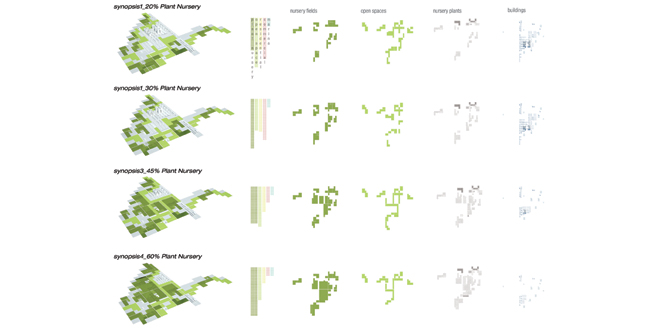 Close Me!
Close Me!Urban Synopsies. Based on different portion of plant nursery and urbanized area, ‘Operative Platform’ will mutate functionally in regards with change of regional context.
Download Hi-Res ImageImage: Hansol Kang
Image 17 of 18
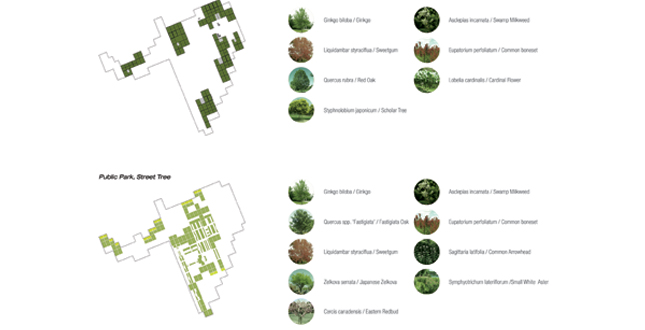 Close Me!
Close Me!Plant Species. Plant species both of plant nursery and open public realm are came from NYC plant list.
Download Hi-Res ImageImage: Hansol Kang
Image 18 of 18
Project Statement
The project provides a vision for an urbanization process that integrates plant nurseries operations and practices as its main structuring system. The project aims to project a novel mode of urbanism that is framed by a productive ecology and integrates a more systematic proposal for a time based dynamic urbanization process. Way to reduce the cost of plant nursery operation and to reframe hydrologic system of Willets Point will be envisioned within this project, the Operative Platform.
Project Narrative
Operative Platform can be situated in close relationship between landscape architecture and urban design. Under the flow of interdisciplinary, landscape architecture stands at the very critical moment, and tries to fulfill new role in whole design field. This project also can be read as a effort to share that discourse and reinterpret contemporary flow with its own manner.
Site is Willets Point, Queens, NY and size of that is about 320,000 square meters. Near the site, La Guardia airport is located on northern part, and Corona park meets with the southern part of the site. Scope of this project is not confined only within the Willets Point but span out to other side of shoreline (to shore of Flushing and of La Guardia airport). The project is informed by a number of obstacles associated with the site. Willets Point’s estuarine hydrology presents a major issue for the site, if it is to be considered for redevelopment and integration into the adjacent Flushing and Corona neighborhoods. The site is currently vulnerable to constant flooding and storm surge. Furthermore, the site is a predominantly industrial site and presents little public as well as ecological value. By reconsidering the nature of the site’s utility as well as reframing the urban system in relation to its dynamic tidal flux, a new nursery urbanism will perform and operate in a manner that works with the hydrological as well as programmatic transformations projected for the site, while simultaneously assembling new urban experiences that will enrich the public and private domains of Willets Point.
In other words, the site presents an opportunity for integrating plant nurseries within the urban environment, transforming the dominant use from a contaminating industry to a productive ecology that will allow for a more efficient and localized mode of rearing urban trees that could be managed to cultivate more hardy tree stock while also potentially providing some remediation for the site. The high costs and inefficiencies associated with transporting seed, seedling and grown plants from remote plant nurseries will be addressed by a more localized urban nursery that would also provide the site with an immediate productive value prior to its impending development. While tree nurseries, structure the redevelopment of the site and bring an immediate economy and value to the site, the projections for future stages of development still retain significant portions of the productive ecology within its urban environment. Besides the performance, economic and ecological benefits, this also provides the site with a distinct character and urban experience that frame the projected lives of the sites inhabitants.
To integrate two starting points what I mentioned above, plant nursery and hydrologic system, the urbanization system comprises a number of typologies based on several nursery types(open field nursery, wetland pond nursery and greenhouse nursery with consideration of water fluctuation and different species) and urban building types(with piloti and terraced structure) informed by the surrounding neighborhoods and adapted for a waterfront site. The overall grid and block are generated from the metrics of a nursery field. The systems are also informed by a combinatorial protocol between the fields, buildings and landscape infrastructure that are deployed throughout the site and adapted to existing site conditions. These can be formulated into four critical combinations that guide the relationships between:
- The urban public realm, nursery fields and low density houses along the shoreline.
- The marina, and a dynamic relationship between field and tidal pools.
- The fields and the dominant existing infrastructures of overhead highways.
- The residential and commercial developments with the nursery fields and water channels.
The critical components of the system include:
- A modified bathymetry and series of terraced platforms along the shoreline that are engineered to control the water direction and facilitate current flow. Each platform has its own specific morphology and configuration to redefine the shoreline and high tide edge condition. The new shoreline will reconnect a larger regional system of green and water infrastructure that traditionally ran through the site.
- Channels and basins will operate as an integral part of the in site water management, including sewage treatment, flooding control and irrigation (brackish for salt hay cultivation and treated storm water for nurseries).
- Nursery fields. Different platforms and field parcels will accommodate different types of nurseries and these are orchestrated in a systemic relationship.
- Green public spaces and buildings have different usage and program that contribute to reorganize urban frame of the site, Willets Point.
The site transformation require some critical phases, however the subsequent development will be flexible and open to market dynamics. These critical phases start with the shoreline and bathymetric reconfiguration. The existing road system of the site are then renovated and extended and subsequently the platforms and channel systems will be implemented. The subsequent distribution of tree fields and buildings are more flexible in their phasing but are guided by considered relationships.
Several images show the way to grab the new urbanism made by ‘Operative Platform’. With those views, we can get a general picture of renewed Willets Point, relationship between fields and highway (one of the dominant existing infrastructure), building with channel system, waterfront park, marina and newly defined inter-relation between urbanized are and plant nursery. Lastly, 4 synopsises based on different portion between plant nursery and urbanized area shows various mutations of operative platform. With those differentiated scenarios, this project prepares several stories and operates functionally that can respond to regional change.





